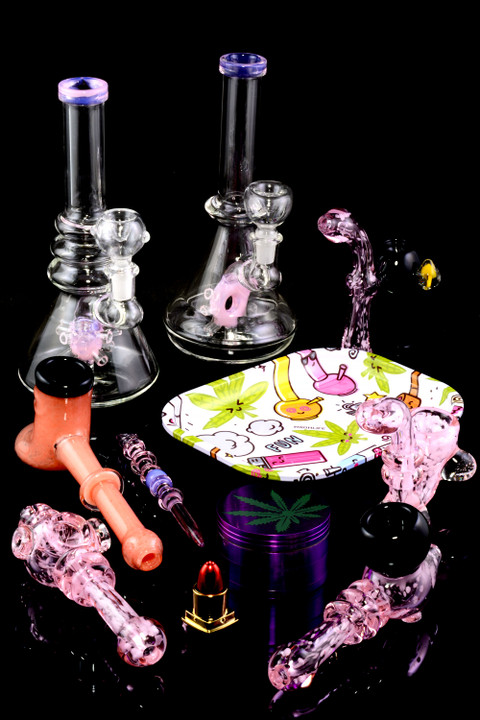Pipe Dreams: Smoking Hot Women’s History
Smoking did not come about as an overnight habit or sensation, as many are well aware, nor was it entirely male-dominated from the industry’s inception. What is seldom brought to the forefront, though, are women’s contributions to bolstering the trade forward and not leaving it just a smoldering pile of ash.
What was once unfathomable to society was a woman behaving in an unladylike fashion, or in accordance with how males behaved or what they partook in, so anything from wearing pants, to voting, to smoking in public has now become commonplace and surrounded with less stigma. However, the latter of the examples is what the late 1920s tobacco industry interpreted as an ideal marketing opportunity when they identified cigarettes as “Torches of Freedom” and paid women to hold and smoke these so-called “Torches of Freedom”, a once illicit act, in a 1929 Easter Sunday parade. Exploiting the longing of so many women to feel on a level playing field, the tobacco industry intentionally sought out models who were “not too good looking”, manufactured ivory tips for a more elegant appearance, and used key words such as “slim”, “mild”, and “light” to perpetuate a false sense of beauty and autonomy while also effectively removing the taboo and the element of shame to any potential female consumers, ultimately at the detriment of their health and well-being.
Fast forward past many successful marketing campaigns by tobacco companies targeted at women to the early 1980s, where the Surgeon General first indicated the consequences of smoking for women specifically, while simultaneously the smoking rate for women being at a near-high (29.3% vs. the 1965 and ‘70s rates being 33.9% and 31.5% respectively). However, despite this, companies were relentless in their pursuit of expanding the market and enrapturing women in the “art of smoking” until the mid- to late- ‘90s, when public opinions began to shift more generally away from smoking tobacco, and restrictions were sanctioned on smoking indoors and in businesses.
In other parts of the world and much earlier than the 1920s, women were gatherers, herbalists, and healers, if they weren’t revered as witches and prosecuted for their “crimes”. The most obvious example of this was the burning of Joan of Arc at the stake for using so-called “witching herbs” (mandrake), and the Bible crudely alluding to an ancient Sumerian goddess of War and mother of herbal healing by the name of Ishtar, and a Semitic invasion denouncing her worship. Initially, these herbs were burned as incense, and acted as a sort of ritualistic homage and worship to the goddess but that, too, was eventually undermined after the patriarchy (literally) took over by hypersexualizing goddesses and transforming them into sex idols. By 1000 BC, goddesses had been converted into meaningless shells of their former glory and was the start of many female-led traditions becoming male-dominated or otherwise eradicated from practice entirely.
The Dark Ages could not be bothered to be lit, both literally and figuratively and the only grim light was from the 1400s Joan of Arc’s burning at the stake. While Christianity may have been a driving force in much of the pushback against women and their involvement in herbal remedies, in the 12th century, Hildegard of Bingen worked and communicated closely with the pope, while also leading a life as a Christian mystic who tended to a garden of hemp and complied two volumes on herbal medicine. In this case, her holistic approach was accepted due to the inclusion of the idea that “man is a unique and spiritual being”, and her embrace of serving the church as a nun while pursuing her individual passion for natural medicine. She was one of the few women to have a voice on medicine during a time when the precedence was a silent and subservient woman.
Another notable woman who spoke out on the potential benefits of smoking and herbs was Queen Victoria of a rather conservative 19th century England, and while she wasn’t a scientist, she used her personal anecdotes and experiences to push a progressive agenda. The push continued with Louisa May Alcott, who used the power of literature to exemplify the use of herbs in her mostly-unheard-of story called the “Perilous Play”. Following suit, was Maya Angelou who depicted her experience with herbs in “Gather Together in My Name”. Along came anthropologist Margaret Mead, who seemingly thrived on controversy, but was outspoken in the late ‘60s on hemp and its’ lack of ill effects compared to that of tobacco. Further down the line was “Brownie Mary”, Mary Jane Rathbun, who was a healer in her own right and distributed medicated brownies to AIDS patients, despite numerous arrests.
We are no longer living within the Dark Ages, and what used to be “Torches of Freedom” have become “Blazes of Glory”, that can now be considered a commodity for general use, with fewer restrictions than before. Not to say there isn’t more room to trailblaze as history is always looking for the pipe-oneer, and you may be next. Why not celebrate a little women’s history by checking out our supply of wholesale pipes and bulk water pipes for resale? A little rebellion never hurt anybody (except Joan of Arc, R.I.P).
Disclaimer: All of our wholesale pipes are for legal use only.
Explore Popular Articles
A New Day, A New Dab: The Dawn of the Daybreak Peak Pro 3DXL
Just in time for the heat of summer, Puffco has released one of their most attractive colorways yet:...
Ease Your High, Not Your Style: High-Not's Plant-Based Solution
Have you ever been one toke over the line? Have you ever eaten just a little bit more of that browni...
King of the Wrap Game: Why King Palm Reigns Supreme
Established in 2016, King Palm has been around for almost a decade yet drew inspiration from smoking...
The American Pipe Dream: Wholesale Smoking Accessories Made in the USA
Though tariffs have cooled down from what they were only a month ago, consumers remain unsure about...
Ooze the Boss? The Brand Dominating the Vape Game
Made for smoking enthusiasts, by smoking enthusiasts, Ooze humbly slid onto the vaporizer scene in 2...
Mocha the Most of the New Puffco Pivot Colorway!
The Puffco Pivot was released just over 5 months ago, yet it continues to go in the same direction:...







